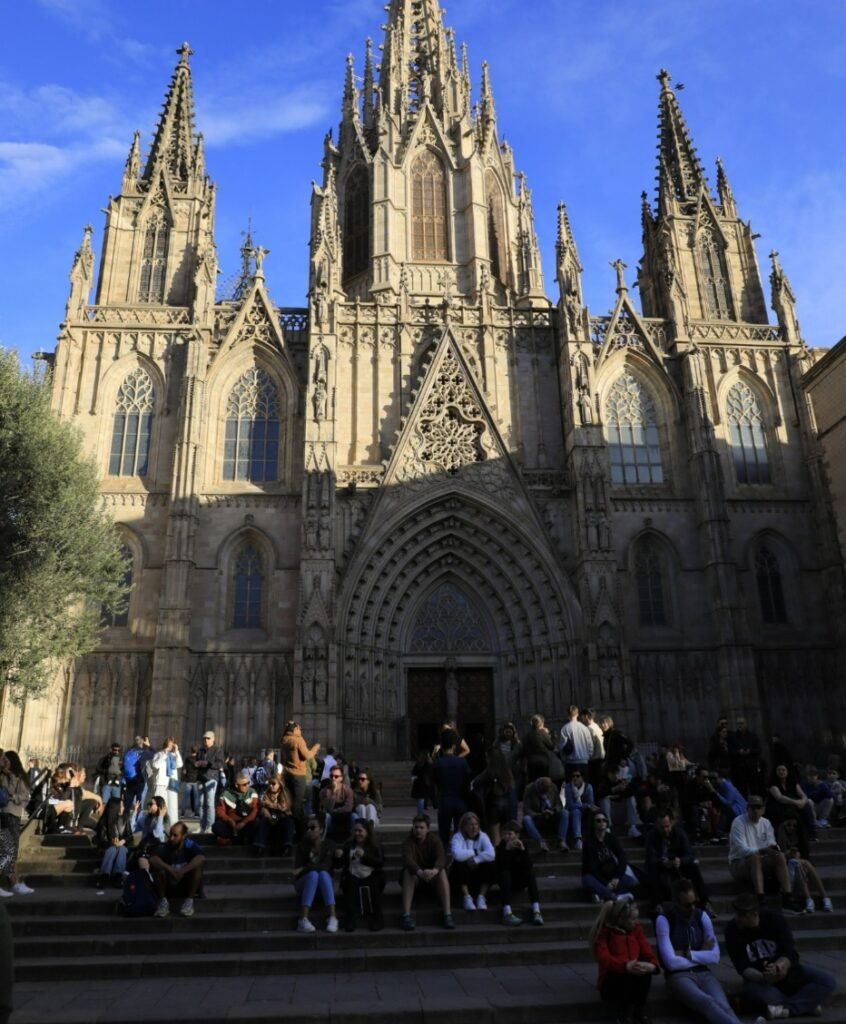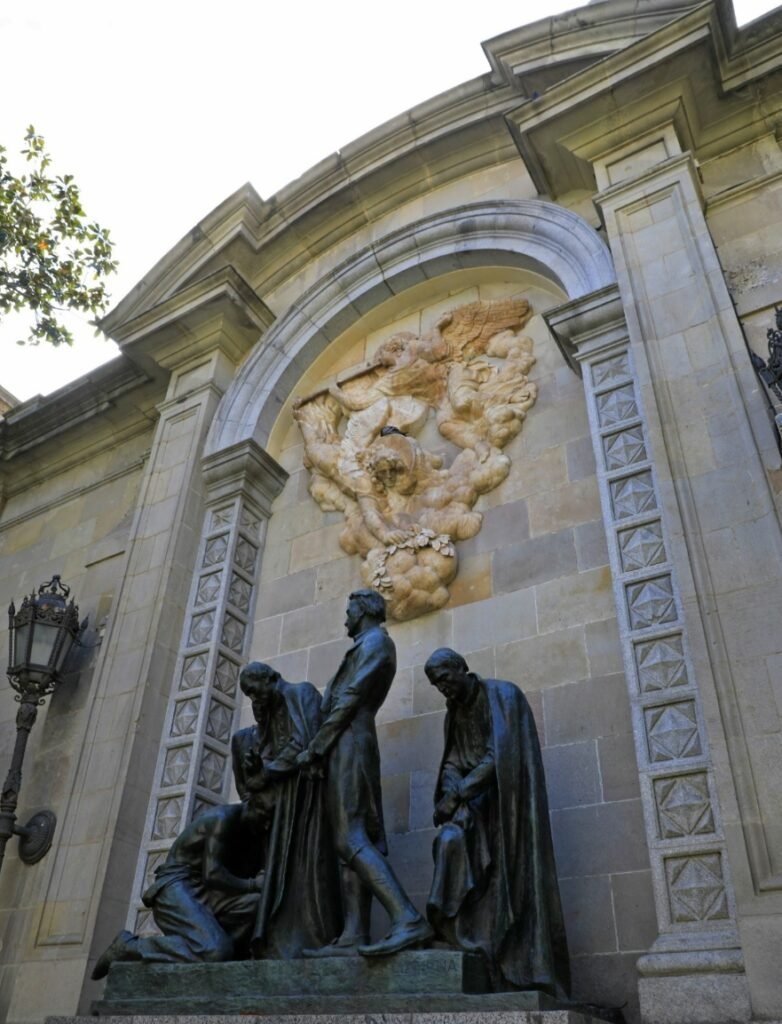The name “Barcelona” originates from ancient Phoenician and dates back to before the rise of Rome. In the 1st century BC, it became a Roman colony, and the city built by the Romans laid the foundation for Barcelona’s old town. The widespread ancient Roman ruins are a source of pride for this city.


The cathedral is the heart of Barcelona’s old town. The Barcelona Cathedral, the seat of the Archdiocese of Barcelona, was first built in the 13th century and took 150 years to complete. Its stunning facade wasn’t finished until the 19th century. The cathedral is a Gothic masterpiece with a mix of different styles, and its deep sense of history is something even the Sagrada Família can’t quite match.


The cathedral’s facade is gorgeous. The main entrance is flanked by statues of the 12 apostles, with smaller sculptures forming a leaf-shaped lintel above the door. The week before Easter, known as Holy Week, is one of Spain’s most beloved traditions, commemorating the passion, death, and resurrection of Jesus Christ. In Catalonia, the Holy Week processions are solemn and serious, while in Madrid and the southern regions of Spain, the celebrations are lively and festive.

Spectators can follow the procession’s cross into the church and partake in the Eucharist. Notice the four men in black on the right side of the scene; their deep, resonant voices chant hymns, moving everyone present. Around the main cathedral, there are medieval ruins and the City History Museum that you can visit for free. Spend some time daydreaming in the cathedral square and wandering the narrow surrounding streets to soak in the ancient city’s character and unique urban beauty.

Tucked away in the narrow streets, the Church of the Sea Virgin is one of Barcelona’s top three churches.

Barcelona is internationally recognized as the city that blends ancient and modern civilizations most perfectly, and it’s a true temple of architectural art. Its squares are historical witnesses to the development of European cities and public life. Plaça de Catalunya, Plaça de la Pau, and Plaça d’Espanya hold significant positions in Barcelona.
Plaça de Catalunya is the heart of both the old town and the expansion areas. It’s where several major streets, including Passeig de Gràcia and La Rambla, intersect, making it the hub for shopping, entertainment, and transportation in Barcelona.

With the completion of the Industrial Revolution, the 19th century saw rapid urban expansion in Barcelona. Renowned architects such as Antoni Gaudí, Lluís Domènech i Montaner, and Josep Puig i Cadafalch showcased their talents in the development of the city’s extension district surrounding the old town. Their work reflected the Catalan awakening and modernist aspirations, earning Barcelona the title of the “World Capital of Architecture.”
An early morning walk near Plaça de Catalunya, in the “Block of Discord,” offers a wonderful experience. The row of buildings, each uniquely captivating, reveals masterpieces by these great architects. Strolling through the morning glow and exploring the city’s urban aesthetics is a delightful way to connect with the spirit of Barcelona.
Casa Milà, built between 1906 and 1912, was commissioned by Pere Milà and Roser Segimon and designed by architect Antoni Gaudí. The building is called “Casa Milà” because it became the new residence of the Milà family. The couple lived on the main floor, while the remaining floors were rented out.
Casa Milà stands out as one of Gaudí’s most representative works of residential architecture, both for its architectural and functional innovations and for its decorative and interior design. It is regarded as a true masterpiece.
Due to its appearance resembling an open quarry, the building is also known as “La Pedrera” (The Quarry), showcasing forms inspired by nature. As Gaudí’s last residential work, it represents a departure from the conventions of his time.


Park Güell
Park Güell is located on El Carmel Hill in Barcelona and was designed by Antoni Gaudí. Built between 1900 and 1914, it officially opened as a public park in 1926. Initially, the park was intended to be a residential area, but the project, developed by Eusebi Güell, was not commercially successful. Inspired by the British Garden City movement, Güell chose this barren hill with little vegetation, aiming to create housing that would benefit from fresh air and scenic views. However, only two houses were built, one intended as a show home. Completed in 1904, it failed to attract buyers, and Gaudí, at Güell’s suggestion, used his savings to purchase it. He moved in with his family in 1906 and lived there until 1926.
The park’s most famous feature is the “Gaudí Dragon,” a large lizard sculpture covered with mosaic tiles. In addition to its symbolic importance, it serves an essential drainage function and has become the park’s most recognizable landmark. Further up the steps is the Hypostyle Hall, or “Greek Theatre,” supported by 86 Doric columns and designed to manage water drainage and prevent flooding.


Casa Batlló
Casa Batlló is a building renovated by architect Antoni Gaudí in collaboration with Josep Maria Jujol. Originally constructed in 1877, it was remodeled between 1904 and 1906. The most exquisite part of the house is the main hall on the first floor, where the Batlló family lived. It has a private entrance and staircase, reflecting Gaudí’s signature naturalistic style.
Gaudí’s distinctive, inimitable architectural artistry and authentic modernist craftsmanship can be seen throughout the main hall. Tickets can be purchased on-site without booking online, though it is recommended to avoid weekends if possible.


The Catalonia Museum of Art is the largest museum in Barcelona, housing nearly 250,000 works, including paintings, sculptures, and other art forms, spanning a thousand years from Romanesque art to the mid-20th century. It prominently features Catalan art. Many of its early collections come from church artifacts confiscated in 1835 and include masterpieces by artists such as El Greco and Diego Velázquez. If not for time constraints, I could easily spend an entire day exploring this museum.




